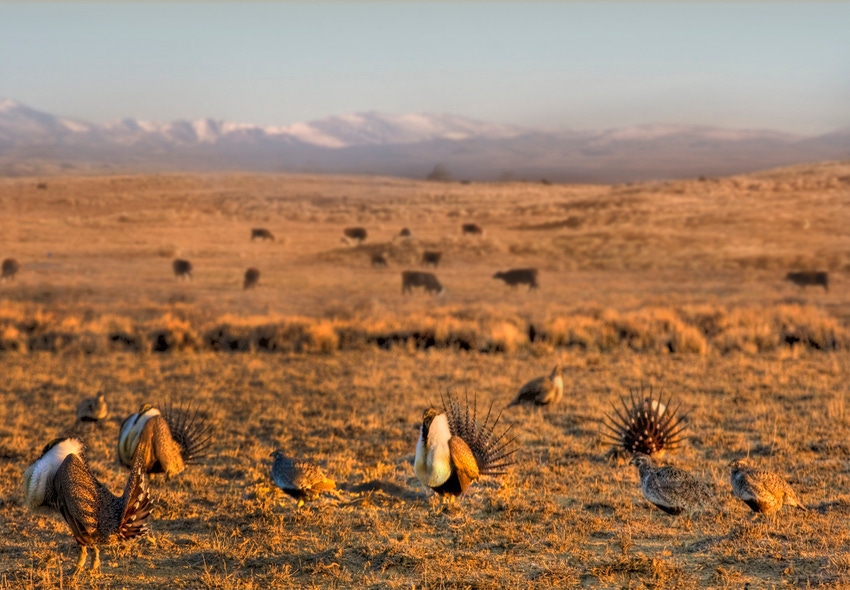Modifications made to sage grouse land use plans
Goal is to better align management for the bird between state and federal agencies.
December 10, 2018

The Bureau of Land Management (BLM) revealed its revised plans to conserve greater sage grouse populations across nearly 70 million acres of public land in 11 Western states. The Trump administration’s approach will replace the original Obama-era plans, which helped to give the U.S. Fish and Wildlife Service confidence that the species did not warrant listing as threatened or endangered in 2015.
During Secretary of Interior Ryan Zinke’s review of sage-grouse management, the governors of most of the affected sage-grouse states asked the BLM to revisit the plans and adapt them to better meet their individual needs.
In response, the BLM developed the changes in collaboration with governors and state wildlife agency professionals in the seven affected states, as well as other concerned organizations and individuals, largely through the Western Governors Association’s Sage-Grouse Task Force.
Ethan Lane, executive director of the Public Lands Council and National Cattlemen’s Beef Assn. Federal Lands, shared the Trump Administration and the Department of Interior came in and did what the previous administration failed to do which was get consistent with states’ ongoing management to ensure the right kinds of tools are on the ground to create a habitat for the bird that doesn’t sideline activities that allow the bird to coexist such as grazing.
Lane said the last administration put things in the plan that were inappropriately targeting grazing that led to reductions in grazing of areas that need fuel loads managed. An example was where half million acres burned in Nevada that was an area where grazing where reduced heavily because of sage grouse plans.
“The 2015 Sage Grouse plan amendments failed to incorporate critical input from local stakeholders and risked causing serious damage to sage grouse conservation efforts. We are pleased to see the administration continue its efforts to bring the 2015 amendments in-line with state plans that better account for the diverse ecosystems across the West. Secretary Zinke and his team deserve our thanks for walking the walk and listening to those closest to the ground. We cannot afford to take important management tools like livestock grazing out of the toolbox,” Lane said.
While the state-specific plans maintain the basic framework of the originals, which were created through years of collaborative effort, the new plans do not provide the same safeguards for certain sagebrush habitats. There is more potential for development and mineral extraction within sage grouse habitat in the new plans. Combined with the Department of Interior’s policy shift to not require habitat mitigation, this could be cause for concern, according to a release from the Theodore Roosevelt Conservation Partnership.
“These new plans are a mixed bag, with some changes addressing legitimate requests from the states to help align with their conservation approaches and other changes stripping back protections for core sage grouse habitat and creating more uncertainty for the West,” says Whit Fosburgh, president and chief executive officer of the Theodore Roosevelt Conservation Partnership. “Unless the impacts of development are properly mitigated to avoid further habitat loss, sage grouse could easily become a candidate for the threatened and endangered species list yet again. Success will ultimately come down to implementing these new plans to the letter, and never wavering from an approach that produces results for sage grouse populations and other species that depend on the sagebrush ecosystem. We will continue working with the BLM, the states, industry, and local partners to ensure that happens.”
The revised plans eliminate focal areas, a subset of about 11 million acres of priority habitat on BLM land that would have been permanently withdrawn from any potential mineral extraction in the 2015 plans. The original no-surface occupancy policy remains—so infrastructure for development cannot be built on priority habitat—but the revised plans also give the BLM more flexibility to waive these protections in certain cases.
It will be important to move forward swiftly with implementation of any plan to conserve sagebrush habitat and begin tracking the effectiveness of conservation measures. “Whatever approach we take, the outcome for sage grouse and sagebrush habitat will need to be legally defensible,” says Dr. Steve Williams, president of the Wildlife Management Institute and former director of the U.S. Fish and Wildlife Service. “If there is not enough regulatory certainty, if there is too much flexibility leading to negative impacts on habitat, and it is determined that our actions were not effective, we may end up facing a legal challenge deeper than the one we started from years ago. At that point, it’s difficult to see a future where sage grouse aren’t reconsidered for listing.”
“The scale and magnitude of sage grouse conservation planning, while extraordinary, has always been an enormous experiment, and management actions largely remain untested,” says Dr. Ed Arnett, chief scientist for the TRCP. “We need solid research and monitoring to demonstrate that management efforts implemented in these plans are, in fact, good for grouse. Until we see conservation manifested on the ground, we still just have good intentions for habitat and birds on paper in planning documents.”
Lane said he expects conservation and environmental groups to lob lawsuits at whatever the final plan is determined to be. However, he was fairly confident the Department of Interior had factored that into their decision-making and the final plan will be able to withstand legal scrutiny.
You May Also Like



